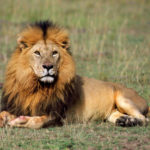The lion is a fierce animal that belongs to the cat family. For centuries, they have been associated with courage, strength and pride. This large feline’s image is used in many national flags, coats of arms, and even crests to symbolize power or courage.
There are two main sub-species of lions that exist today, as categorized by the part of the world they live in. The first sub-species is the African lion that dwells in Southern and Central Africa.
The other one is the Asiatic lion found in Gir forest, India. To many people, these two lion-subspecies resemble each other. However, upon close examination, you will discover that they exhibit noticeable differences in diet, habitat and size.
Also read:
Lion Information & Facts For Kids
- In the big cat category, Lions are the second largest, after tigers. They grow up to 8 foot long and weigh about 500 pounds while tigers grow up to 11 foot long and weigh 850 pounds.
- Lions are social animals that live in groups that consist 15 to 40 related females and offspring, known as prides. A pride mostly has all females except for one to three territorial males that are also related.
- Although famously called “King of the Jungle,” lions don’t actually live in the jungle but in plains and grasslands.
- Lions are very organized animals. They work as a team and roles are usually divided amongst pride members. The work of the female lion is to hunt, which it does as a team, while the male protects the pride and territory.
- Female lions and their cubs often stay with each other. So in a typical pride all the females are usually sisters.
- The closest relative to the lion is the Tiger. Other relatives of the Lion are jaguars and leopards.
- There is a stray lion sub-division called mountain lions (pumas). These are actually not categorized as lions although they come from the same family
- A male lion roars the loudest amongst all the big cats. Their roar helps them find other lions and declare their territory, which can cover up to 100 square miles. The roar can echo up to a five miles radius.
Diet
Lions prey on large animals, including wildebeest, Zebras, antelopes, buffalo, impala, giraffes and hippos. During food scarcity, they also kill rhinos and elephants and may snatch scavenged food from leopards, cheetahs and hyenas. They are also known to feed on small animals like tortoise, lizards and mice. Asiatic animals also eat sambhar, chital, nilgai and goats.
Habitat
In the past, lions roamed the Middle East, northern India, Greece and throughout Africa. However, today they are only found in eastern and southern Africa, south Sahara desert and in Gir forest in India. In these places, they live in woodlands, dense bush, grasslands and savannas.
Behavior
Asiatic lions always live in two separate prides - a male dominated pride and a female dominated pride; and they unite only during the mating season. In contrast, African lions live in prides that consist mainly of females and their cubs, with one to three males depending on the pride's size.
Members of a pride are usually very close and affectionate towards each other and can be seen licking and purring, head rubbing and touching each other a lot when they’re resting.
Lifestyle
Although lions are social, they don’t show solidarity when it’s feeding time. They fight when a kill is brought by the lioness, and typically the male lion will eat first followed by the female lions and lastly the cubs. These big cats are very lazy and sleep and rest for 16 to 20 hours per day, only hunting during the remaining hours. Male lions don’t stay in one pride for the whole life, as they are usually challenged or killed by another male that takes over the pride usually after three years.
Predators
Humans have been the main predators of lions for years. They are killed in some African communities as a part of customs for their magical and medicinal abilities and also for trophies. Livestock predation has also been challenging to tackle.
Breeding
Lions reproduce throughout the year. Their gestation period is about 110 days, and they produce three to four cubs with each pregnancy. In a typical pride, two or three female lions are always pregnant at the same time. The male lions that head the pride sire the cubs.
Appearance
Lions are generally tawny yellow in color. However, the lions living in dense forest appear to be darker, while the ones in hot arid areas appear lighter in color. The end of their tails has the shape of a horny spine with a tuft of hair. Mature male lions feature a mane of black or brown hair circling their neck and head.
Lifespan
- Cubs are protected by their mothers up to the age of two and after that they can start hunting. At the age of two or three, male lions leave the pride and form bachelor groups. The females start mating when they are 4 years old to reproduce.
- Lions live for about 10 to 14 years in the wild, and in few cases, up to 18 years. In captivity, they live for 13 to 30 years.
Images, Pics, Photos and Pictures Of lion :
Health Issues
Although lions can go for four to five days without water, when there is water available they drink it daily. Lions living in arid area get water from the stomach contents of their prey.
Grooming
Male lions are known to frequently groom their coats. African lions enjoy living in the grasslands since their tawny coloring makes it easy for them to blend.
Shedding
Lions generally don’t shed their coating. However, to stay warm in cold season, their fur tends to grow longer and thins in warmer weather. Interestingly, a research on lions in Tsavo, Kenya found that the animals delay the growth of their mane deliberate (lion boldness). Most male lions in Pendjari National Park also don’t have manes or have weak manes. One hypothesis is that this could be a copying strategy.
Lion Interesting Fun Facts
- The International Union for Conservation of Nature’s (IUCN) Red List of Threatened Species has listed the African Lion. They are feared to be extinct by 2050.
- There are only about 350 Asiatic lions existing today, 175 of which are mature lions. This makes them even more endangered.
- To avoid competition during pride succession, male African lions are said to kill all of the cubs and the new males sire other cubs.
















